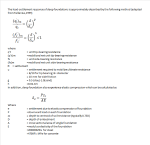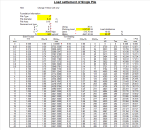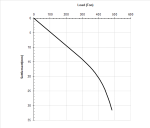Single Pile Load vs settlement

Description
This spreadsheet estimated load settlement curve for single pile (circular) either concrete or steel based on Fellenius method (1999)
Calculation Reference
Pile Settlement
Foundation Design
Fellenius Method
The Fellenius method (also known as the Unified Pile Design or the α - β - γ method) is an approach for analyzing the load-settlement behavior of a single pile. It was proposed by Bengt Fellenius in 1989 and further refined in subsequent publications. The method considers the distribution of axial load along the pile shaft (skin friction) and the pile base (end-bearing) and allows for a better understanding of the pile's behavior under various load levels.
Here are the steps for analyzing the load-settlement behavior of a single pile using the Fellenius method:
-
Gather necessary information: Collect site-specific information, such as soil properties, groundwater conditions, pile dimensions, and material properties (concrete or steel).
-
Conduct pile load tests: Perform static pile load tests by applying incremental axial loads to the pile and measuring the corresponding settlements. The results will be used to develop the load-settlement curve and calibrate the analysis.
-
Determine the t-z and q-w relationships: The Fellenius method relies on empirical relationships between the pile's skin friction (t) and relative pile-soil movement (z) and between the end-bearing (q) and pile base settlement (w). These relationships can be obtained from the literature or established based on the results of pile load tests and local experience.
-
Calculate the load-transfer curves: Use the t-z and q-w relationships to compute the load-transfer curves along the pile shaft (α) and at the pile base (β). The α and β values are dimensionless coefficients that represent the fraction of the total pile load that is carried by skin friction and end-bearing, respectively.
-
Compute the load-settlement curve: Sum the α and β curves along the pile length to obtain the total load-transfer curve (γ). Then, integrate the γ curve to compute the cumulative settlement along the pile length. Plot the load versus the settlement to obtain the load-settlement curve for the single pile.
-
Calibrate the analysis: Compare the computed load-settlement curve with the results of the pile load tests. Adjust the t-z and q-w relationships, if necessary, to achieve a better match between the computed and measured load-settlement behavior.
-
Evaluate the pile performance: Use the load-settlement curve to assess the pile's performance under various load levels, considering factors such as the maximum allowable load, the settlement tolerance, and the factor of safety.
It is important to note that the Fellenius method is an empirical approach that relies on the quality of the input data and the accuracy of the t-z and q-w relationships. Therefore, it is essential to have reliable site-specific information and to consult with experienced geotechnical engineers when applying the method to analyze the load-settlement behavior of single piles.
Calculation Preview
Full download access to any calculation is available to users with a paid or awarded subscription (XLC Pro).
Subscriptions are free to contributors to the site, alternatively they can be purchased.
Click here for information on subscriptions.




